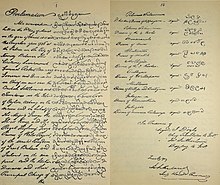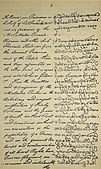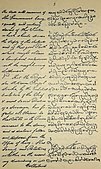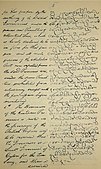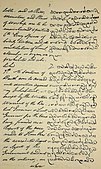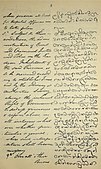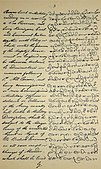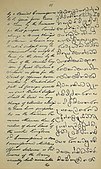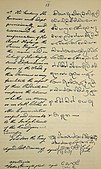Kandy Convention
The Kandy Convention ( English Kandyan Convention , Sinhala උඩරට ගිවිසුම Udarata Giwisuma ) was an agreement that was signed on March 10, 1815 between the British Empire and high-ranking dignitaries of the Kingdom of Kandy to depose King Sri Vikrama Rajasinha and cede the kingdom to British rule .
background
In Sri Lanka violent conflicts at that time were fought for supremacy. The king, a member of the Nayaks of Kandy ( Kandyan Nayak Dynasty , Sinhala: මහනුවර නායක්කාරවරු, Tamil கண்டி நாயக்கர் , of South Indian descent) faced a powerful opposition from Sinhala dignitaries who wanted to curtail his power. After a successful coup d'état by the chiefs, the king was deposed, captured and imprisoned in Vellore, ending the 2358-year self-determined rule on the island. The treaty is unique in that it was signed not by the monarch but by members of his court and other dignitaries of the kingdom. Thus the colony of British Ceylon came into being .
The convention gained some negative notoriety when, according to later sources, the Buddhist bhikkhu Wariyapola Sri Sumangala took control of a Union Jack that had been planted by the British and trampled on it, demanding that the Kandy flag be hoisted for at least that long should remain until the contract was signed.
The authenticity of the signatures of the local dignitaries has recently been called into question.
Signatory
British
- Robert Brownrigg - Governor of Ceylon
- John D'Oyly - Chief Translator Translator for the Government
- Yes. Surtherland - Deputy Secretary
Kandyer
- Married Pola Nilame
- Molligoda sr. - Maha Adigar & Dissawa by Sath Korles
- Pilima Talawuwe sr. aka hooded cotton wool - 2nd Adigar & Dissawa by Sabaragamuwa
- Pilima Talawuwe Jr. - Dissawa from Hathra Korles
- Monarawila - Dissawa from Uva
- Ratwatte - Dissawa from Matale
- Molligoda Jr. - Dissawa from Thun Korles
- Dullewe - Dissawa from Walapane
- Millewe - Dissawa by Wellassa & Binthenna
- Galagama - Dissawa from Tamankaduwa
- Galagoda - Dissawa from Nuwara Kalawiya
main points
- 'Sri Wickrema Rajasinha', the ' Malabari ' king, [must] renounce all claims to the throne of Kandy.
- The king is declared fallen and deposed, and his dynasty's claim to inheritance is revoked and extinguished.
- All of his male relatives are banned from the island.
- The Dominion is transferred to the sovereignty of the British Empire, which is carried out by the Colonial Governors, with the exception of the Adikarams, Disavas, Mohottalas, Korales, Vidanes and other subordinate officers (civil servants), whereby their rights, privileges and power are within their respective Ranges is obtained.
- The religion of Buddhism is declared inviolable and its rights are preserved and protected.
- All forms of physical torture and mutilation will be abolished.
- The governor alone can sentence a person to death and all corporal punishments carried out in the presence of accredited government agents.
- All civil and civil jurisdiction over people of Kandy is to be applied according to the established norms and customs of the country, the government reserves the right to decide when it is necessary.
- Other items unrelated to Kandy [privileged as before] under British Law.
- The proclamation on the annexation of the Three and Four Korales and of Sabaragamuwa is withdrawn.
- Duties and taxes are collected for the King of England and for the maintenance of the island's internal facilities.
- The governor alone can allow trade and commerce.
document
The original of the Government of Sri Lanka Treaty (contains original copies of the Convention).
literature
- Humphrey William Codrington: Short History of Ceylon . Asian Educational Services, New Delhi 1995, ISBN 81-206-0946-8 , pp. 174 ( books.google.com - no page view). }
- RB Herath: Sri Lankan Ethnic Crisis: Towards a Resolution . Trafford Publishing, Victoria, BC 2002, ISBN 1-55369-793-6 , pp. 27 ( books.google.com - no page view). }
Web links
- British Ceylon and Kingdom of Kandy 1805 (map)
- The Kandyan Convention and British policy
- 1815: Kandyan Convention and the Role of D'Oyly
- The 1815 Kandyan Convention at the Audience Hall
- The signing of the Kandyan Convention
- Kandyan Convention of 1815
- Kandyan Convention of 1815 by Dr. KDG Wimalaratne
Individual evidence
- ^ Nihal Karunaratna: Kandy, past and present, 1474-1998 AD . Ministry of Religious and Cultural Affairs, Kandy 1999, ISBN 955-613-121-3 , p. 116.
- ↑ Lalith Gunawardena: රටම රැවටූ උඩරට ගිවිසුම. (raṭama rævaṭū uḍaraṭa givisuma: Kandyan pact that deceived the country) Divaina, divaina.com March 3, 2010.
